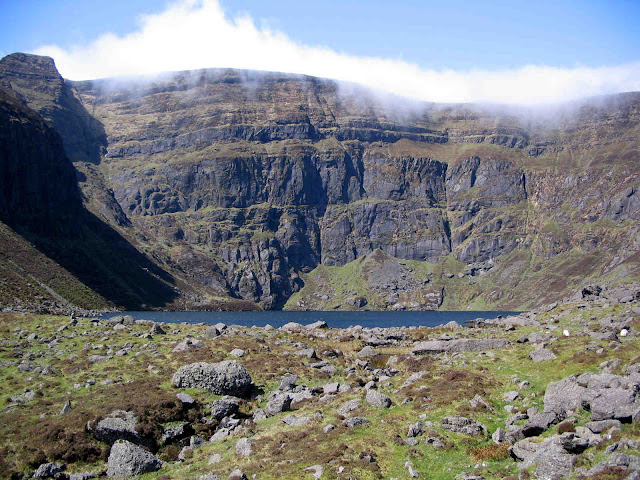A Special Comeragh Place - Glenary
 |
| Carey`s Castle |
Where is Glenary?
Nestled in the north-west corner of Waterford near Clonmel is Glenary, the name originating most likely from “Gleann an Aoire” – the valley of the shepherd. Canon Power thought it may have come from “Gleann Aimhréidh” meaning uneven/rough valley. Some people say the name means crooked valley, and the valley does take two very definite changes in direction. The valley, running mainly from west to east and lying between Boolabrien Ridge and Long Hill, is drained by the Glenary River which rises on the slopes of Lachtnafrankee to the east and flows west into the Suir near Kilmanahan. A little-known area this but it is well worth a visit.Getting there
From Clonmel take the R671 towards Dungarvan. Less than 1 kilometre after the turn-off for Dungarvan take the first left and continue uphill for about a kilometre to a forest entrance on the left signposted “Carey`s Castle”. There is plenty room for parking here.A Special Place
Some places reverberate strongly with echos from the past and Glenary is certainly one such place. First off there is the mysterious Carey`s Castle. Who was Carey? When was the castle built? And why does it have a strange mix of architectural styles – a Celtic round tower, Gothic windows, Romanesque arches, A Norman keep?The circuit of Glenary is best done in a clockwise direction. Start by walking back along the forest track you drove in on for about 100 metres to the road. Turn right/north and almost immediately turn right/east and follow the Munster Way markers onto a smaller road. Walk along this road for 1.5 kilometres to its end.
 |
| Boreen leading to Glenary Cluster Village/Clochán |
Turn right here, carefully cross the gate and continue east
through a young forest plantation to meet yet another gate after 300 metres. 200 metres later you reach the end of the track at a
gate.
Cross the gate onto a wide track. You will be turning right here into Russellstown Wood but first it is well worth while taking a short detour to locate a lovely lunch spot at the junction of the Coumwhelaun and Glenary streams. So, cross the wide track at the gate and wander downhill on a narrow path to reach the Coumwhelaun stream. Cross it and follow a sheep path down to the right for over 100 metres to the confluence of the two streams. This is an idyllic little spot. Looking uphill in a south-easterly direction along the Glenary towards Boolabrien Ridge can you sense the ghosts of the past following a funeral procession down An Staighre from Glendalaghin in the Nire on its way to Clonmel?
When refreshed, return to the wide track, turn left and walk down to the bridge across the Glenary. Now follow the forest track above the river in Russellstown Wood. After about 1.3 kilometres keep right at the path junction and 1.2 kilometres later, if water levels are low, cross the Glenary opposite Carey`s Castle, which is clearly visible through the trees. Ramble around this interesting building for a while before heading west along the main path to reach your car after 700 metres.


Comments
Post a Comment